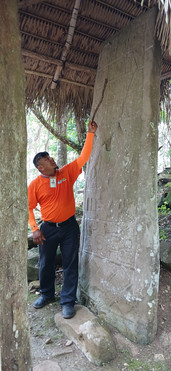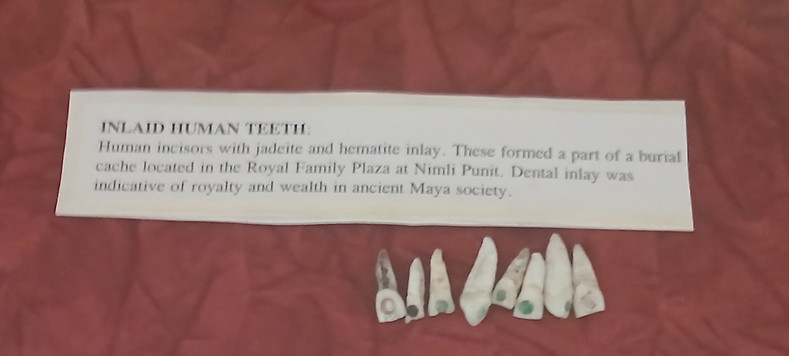Harvest Caye, Belize
- Julie-Anne Justus

- Aug 20, 2024
- 7 min read
Updated: Aug 20, 2024
Belize is the second smallest Central American country (after El Salvador) and has a population of 400,000. It has a strong environmental record; almost 40% of Belize's territory falls under conservation protection. Our various guides throughout the day made many references to Belize being bellissimo or simply (pun alert) 'Belize-imo' and 'unBelizeable'. It does seem nice, actually.
Harvest Caye is a tiny island on the south coast of Belize, owned by Norwegian Cruise Line. A 'caye' is a small island, from the Spanish cayo. All over the Caribbean region, small islands are called cays, cayes or keys. (Like the Florida Keys, but we'll get there.) Various cruise lines own various small islands in the Caribbean, which they develop into cruise ports and tourist playgrounds. One can easily spend a pleasant day at these places — sun, sand, blue ocean, plenty of drinks and food and music. But we're more interested in what's beyond the party.
So, over we go to the mainland by ferry, to Malacate port and the town of Independence.
Belize was settled by the English (not the Spanish!) in 1638. Over the next 160 years the British and Spanish squabbled over the land, until 1798 when Britain defeated Spain in an island battle. Belize became a British colony in 1840 and was called British Honduras. It gained independence in 1981, was renamed Belize (no one is quite sure where this name comes from) and is the only mainland Central American country that is a Commonwealth country.
Okay, that's a very quick history to explain why the town was renamed Independence in 1981.
Many of the villages we travelled through were Mayan villages, with the traditional palm leaf roofs, where Mayan people have lived for thousands of years.
Belize has some interesting modern settlers: the Mennonites and the Amish. While these are fairly small groups, they're quite visible. Most members don't drive, so wait for buses along the road or own a vehicle but have it driven by someone else. I noticed one traditionally dressed Amish man at the bus stop, and another in the tray of a ute/pick-up truck, holding on to his straw hat, being driven by a local.
We visited the Belize Spice Farm, about 40 minutes' drive from the port. We have been to (and loved) other small spice farms in Mauritius, the Comores, Sri Lanka and Malaysia, but this is a larger, more commercial operation than those. A retired Indian doctor bought 500 acres of land in Belize, planted 400 acres with oranges and the other 100 acres with spices. The farm hosts weddings and is developing tourist accommodation.
We were driven around on a teak trolley pulled by a tractor. A parterre has been created of the map of Belize with its six states (third photo below).
I found it interesting that most of the spices we saw were from Africa or Asia; there seemed to be very few native plants from this part of the world.
What is native to this part of the world is cacao, and chocolate is big in Belize. While sugar, bananas and citrus fruit are Belize's major agricultural crops, cacao is becoming increasingly important. Correction — it has always been important in Mayan culture. Chocolate consumption by Mayan people goes back more than 2500 years. Apparently every meal was accompanied by chocolate in some form or another. Sadly it's not cacao season at the farm, so we didn't see any choc-on-the-plant.
One spice new to me was moringa, which can be eaten as well as used medicinally. I have bought it previously as a fragrance in hand cream but I have never eaten it before. (It's like a mild rocket.) In the first photo below, moringa leaves are lying under the cinnamon leaf and next to the ylang-ylang flower. The blue butterfly pea flower was also new to me. It's used to make tea and to give colour to food. Then we have nutmeg seed covered by red mace, peppercorns, dragonfruit plants (those elongated cactus-y plants) and vanilla vines. Saffron is the most expensive spice in the world, followed by vanilla, cardamom and nutmeg. Belize does not have the specific bee that pollinates vanilla flowers, so the flowers have to be pollinated manually by workers, one by one, within the space of 8 hours. With a toothpick! Obviously the labour cost is high.
I'll let our lovely young guide tell you a bit about these ornamentals.

I loved what they were doing with used coconut shells. The farm has orchids growing in these shells, but any epiphyte or air plant could be grown this way. I'm going to try this at home!
The spice farm grows and cuts their own teak for building. The trolley that we were riding on is made from local teak, and the restaurant on-site is panelled with teak. Teak is sustainable, it's fast-growing and timber can be harvested from a tree without destroying it — a few branches from of the tree can be cut and the tree grows new branches. Can you see the huge flight of butterflies in the lumber yard?
But the national tree of Belize is mahogany. Mahogany trees take about 80 years to mature, whereas teak can be harvested after 20 years. The British shipped a great deal of mahogany to the UK; since independence, Belize has tried to conserve the mature mahogany trees that still exist. This is what a mature mahogany tree looks like.

Remember I said that the Mayan people lived across a large area in Mexico, Belize and Honduras? We're off to another ancient Mayan site: the Nim Li Punit site (or the Big Hat site). On one of the stela sculptures (first photo) is a Mayan king wearing an enormous head-dress, hence 'big hat'. Another of the stela uncovered has a jaguar, one of the important animals in Mayan culture. The jaguar protected the sun when it disappeared below the earth at night.
The height of the Nim Li Punit society was between 400 and 700 AD. About 7000 residents lived here, but again, like Chacchoben and many others, was abandoned when it became overpopulated and the climate became unfavourable.
Local Maya people knew about Nim Li Punit, but it was first excavated only in 1976. I draw your attention to a few exhibits below: human teeth inlaid with jade, long predating the rappers with their tooth bling, a double-edged blade made from bone for 'termination rituals' and a human leg bone for bloodletting rituals. We'll come back to the last two objects.
Excavations continued for the next 40 years but it was only in 2015 that the tombs on-site were excavated. The first photo below shows the tomb of a high-status person. (Ordinary people were cremated.) See the two chambers side by side? The chamber in the background, with the covering stones, would be for the dead body. The chamber in the foreground was for his or her possessions, which went with the person to the afterlife. When someone else of a similar status died, the skeleton/mummy and possessions of person number 1 would be removed, sometimes burned, sometimes scattered, and the tomb re-used by person number 2.
The second photo is a royal tomb. Can you see the little 'door' into another chamber? The royal corpse would be buried with his/her possessions. But when another royal person died, the first royal body/skeleton/mummy would be moved into the second chamber, rather than disposed of. So potentially many royal skeletons might be stored together.
A large jade pendant with Mayan hieroglyphs was unearthed in this tomb. It's distinctive because it has 30 hieroglyphs on its back. No one is quite sure (yet) what these mean — they might be incantations to the gods. Kings were responsible for the weather and the rains, so the fact that it was buried might mean it was an offering to the gods.
Jade does not occur naturally in Belize so this would have come from further away, probably Guatemala. Look, we can see Guatemala from this hill!

Nim Li Punit is well known for its astronomical observations. Several stone towers/columns that mark the location of solstices and equinoxes are arranged in a terrace. So these people understood that the position of the sun (or earth) changed during the course of a year.
We came across a determined cavalcade of tree-cutter ants. Apparently the females do all the work. Aren't they impressive? (If you've seen the movie Apocalypto, you'll remember that the Mayan healer uses tree-cutter ants to sew up warriors' wounds.)
Okay, now the grisly bit. This is a sports field. People would sit on steps (like bleachers) to watch two royal men play a game with a rubber ball. The rules of the game are a bit obscure, but the winner earned a higher status. The one who lost was either sacrificed to the gods with the 'instrument of termination' (I love the vocabulary), which means the sharp double-edged blade in the earlier photo would be used to cut the loser's throat.
Another option was for the loser not to lose his life, but instead to provide blood for the gods.
Bloodletting was a ritual affair with strict rules. Only royals were eligible, as the Mayans believed this would please the gods. Remember that carved human bone? It would be fitted with a stingray spine/tail that would be inserted through the loser's tongue, nipple or private parts. (I am observing decorum in this blog.) Once in place, the stingray spine was ripped through the flesh, tearing a huge hole in the person's tongue or nipple or wherever. The resulting torrents of blood would be offered to the gods. The loser would take months (if ever) to heal, and he certainly wouldn't be able to speak or eat while his tongue (or other organ) healed.
Now that puts losing a sports match into proportion, right? One has to wonder whether being killed by that double-bladed knife wouldn't be preferable.
More to come from another port of call.







































































































Commentaires